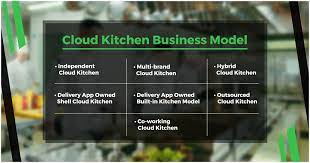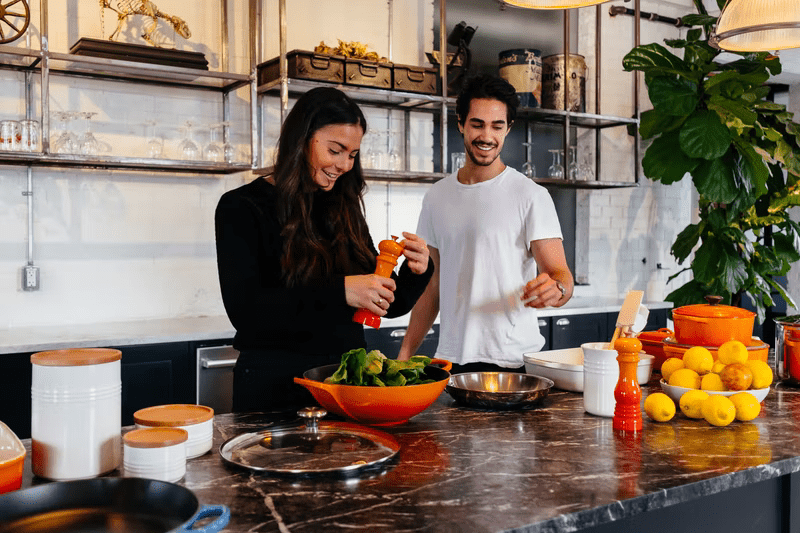Imagine having a long day and then having to cook or dress up and go out. Feeling tired already, aren’t you? That’s why there are cloud kitchens. A Cloud kitchen or a ghost kitchen, call it whatever you like, is basically a restaurant without any physical presence. Why spend money on parking and seating when you can deliver food to the customers without an establishment?
Table of Contents
What is a Cloud Kitchen?
A cloud kitchen or a ghost kitchen is a virtual, professional food preparation/cooking and delivery facility. Some cloud kitchens can also have a physical presence but they can never have a dine-in facility. Drive-throughs are allowed and “self-pick-up” can also be an option. But mostly these kitchens are virtual and you can’t practically eat in them, although they have geographical locations.
A ghost kitchen is not a brand in itself. Multiple brands or just one brand can work in a ghost kitchen and deliver food. Crazy start-up idea right? Well, if you are thinking about it, check out these amazing ideas on how to finance your start-up.
History
In 2015, an NBC New York article first used the term “ghost kitchen”. Entrepreneurs and creative executives lapped it up and the term became famous. Although this particular article was critical of ghost kitchens and unregistered delivery brands, the business idea was still brilliant.
The growth that the cloud/delivery-only kitchen industry has seen in these past few years is largely due to the pandemic. Since 2015 the transparency of delivery brands has increased and people have put their trust in companies like Seamless or Grubhub. Hence, this ghost kitchen industry has grown quite large.
Function
Cloud kitchens can have multiple business models which we will discuss later. On a primary level, a kitchen prepares the food, and through different or one delivery application delivers them to the customer’s doorstep. The kitchen can have drive-through options or self-pick-up options as well. This sounds a little precarious but so did cryptocurrency a few years back. Ghost or cloud kitchens are the future of the restaurant industry as the pandemic has shown us.
7 Cloud Kitchen Business Models

Now let us discuss in detail, the business models viable for cloud kitchens.
The Independent Model
Independent cloud kitchens are the ones with a single kitchen or establishment owned by no brand and have no storefront. It is actually the most common business model for cloud kitchens. The food preparation and cooking happen in one place. The orders usually come in through reliable delivery applications like Ubereats and Grubhub.
After the meal has been prepared and packed inside the kitchen, it is transported by the food aggregator or by the kitchen itself, if the order came directly to the kitchen. Sometimes larger companies, for example, a cupcake shop, can call in an order if the kitchen makes cupcakes. It is up to the kitchen to decide if they want to go along with the order.
These kitchens don’t have a physical presence or somewhere you can go and check. But stay assured they, like any other restaurant, have to go through regular hygiene check-ups. Mr.Beast Burger follows the independent model.
The Brand-Owned Model
For this second model, we have cloud kitchens that have no storefront but have one establishment that is owned by a single brand. It does not, however, offer take-out, drive-through, or “self-pick-up” options. They are mostly delivery-only establishments. By not offering takeout or drive-through the brand can avoid spending money on a good-looking storefront. The food preparation and cooking take place in a single kitchen.
The orders can be put in through different food delivery applications or they can come in through the kitchen brand’s direct customer base. You cannot find these kitchens in their physical forms either but they too go through health and hygiene check-ups regularly. The brand-owned model is a highly efficient business idea mainly because of agreements between the brand and food delivery apps. The Freshmenu food chain follows this business model.
The Multiple-Brands Model
This is complex, so pay attention. The cloud kitchens operating under multiple food brands and/or restaurants, with various outlets but no storefronts, fall in this category. But how’d multiple brands work while promoting the kitchen? For that, they need an agreement that comes from understanding an area’s local demographics, traditional food, and what the targeted customer base wants nowadays.
To fashion a kitchen so that they promote the distinctness of each restaurant or brand is immensely important. The primary goal is to understand the needs of customers within a range of 5 to 6 kilometers before setting up the cloud kitchen and then expanding from there. Rebel Foods(Faasos) has prospered using this business model.
The Middle Grounds Model
This is one of the rarer models for cloud kitchens. These kitchens can be owned by one single brand or multiple brands and can have one, or more storefronts and more than one establishment for cooking and food preparation. The specialty of this business model is that instead of delivering the orders to the client, they come to the storefront to pick them up. Zomato’s services infrastructure follows the middle ground model.
Many of the cloud kitchens are situated in areas with low pedestrian traffic or population density to save on rent. But deliveries can be expensive this way for regular models. With the middle grounds model, a kitchen can be situated in a secluded area as long as the storefront is reachable, the customers will flow. And even if the storefronts are in areas with low pedestrian traffic, passing-by cars will definitely order. These models, although a bit expensive to set up, save a lot of money.
The Hub and Spoke Model
Hub and Spoke models are usually part of transport topology where various routes connect to a central hub. This is an expensive model. There are variations of the hub and spoke model, like a specific brand, multiple brands, or community kitchens. The idea is to have a central cooking facility owned or leased by a business and then establish other facilities to deliver and cater to the needs of specific areas. So, the central facility can be looked at as the “hub” and the other surrounding facilities will be the “spokes”.
The establishment cost of a hub and spoke model can be a bit expensive because of the facilities you have to rent or make and the staff you have to hire and train. But once in gear, this is probably the most profitable business model as far as cloud kitchen models go. Kitchens Centre operates on this business model.
The Outsourcing Model
This model works on outsourcing the raw material. Some restaurants or shops like to outsource their materials so that the cooks in a ghost kitchen can cook them. These types of kitchens cannot exist on their own, they need to collaborate with restaurants. The Kitopi Kitchen is a famous example of the outsourcing model.
The Commissary Kitchen
A commissary kitchen is mainly seen in a military base where the eateries share everything starting from kitchen space to food supplies. In this case of cloud kitchen business models, no company owns the kitchens. Sometimes, multiple companies and kitchens can share a facility entirely, I’m talking stove to refrigerator space. These kitchens are a collaborative effort at food preparation. They cost the bare minimum. Another name for this is Kitchens at a service(KaaS). Swiggy Access kitchens follow this business model.
Examples of Cloud Kitchen
- Chick-Fil-A: Chick-Fil-A, one of the most famous fast-food chains, has recently signed a contract with DoorDash for delivery-only services, which accelerated both businesses.
- Macdonald’s: One of the largest food enterprises, Macdonald’s has opened its first ghost kitchen outlet quite recently, in Hanworth district, London. A spokesperson for Macdonald’s has confirmed that this is the start of a new worldwide endeavor.
- Franklin Junction: Franklin Junction has created the concept of the “host kitchen” by utilizing the excess kitchen space by restaurants and helping them monetize it. They recently signed a deal with GrubHub.
- CloudKitchens: The founder of Uber, Travis Kalanick, has invested $150 million in the low-price and undervalued storage spaces through City Storage System to set up that space for cloud kitchens and rent them out to other kitchens.
- Rebel Foods: Rebel food started as Faasos in 2011 and has become one of the topmost cloud kitchen brands. It currently owns 11 cloud kitchen companies like Behrouz Biryani, Sweet truth, Oven Story, etc. As of 2021, they own 320-plus establishments devoted to the ghost kitchen business.
- Mr. Beast Burger: Jimmy Donaldson, known as Mr. Beast himself, founded the Mr. Beast Burger delivery-only fast food chain. They have over a thousand establishments all over Europe and North America and mainly serve burgers, fries, desserts, and canned beverages.
Advantages of A Cloud Kitchen
As a start-up idea, cloud kitchens are brilliant. Here’s why–
- Low set-up cost: We have seen the business models of a ghost kitchen and none of them can ever cost as much as a full-fledged restaurant.
- Easy-to-extend: Cloud kitchens barely need any additional promotion thanks to the array of delivery apps that advertise them and once they acquire enough customers, extending the menu becomes easier as well.
- Low overhead: Cloud kitchens can avoid the increasing tax rates on property and business facilities simply by their inherent design and device.
- Rapid deliveries: The cooking and delivery can be simultaneous in effective cloud kitchens which leads to customer satisfaction.
Cloud kitchen primarily means a delivery-only restaurant that can occasionally have drive-through to takeout options and can be independent or owned by one or multiple brands.
Cloud kitchens can make money through different business models but mainly through collaboration with food delivery apps and delivering the food to the customer.
It is beneficial for business owners because of the low set-up cost, collaborative promotions, and profitable agreements with delivery apps. And for customers cloud kitchens provide low-cost and high-quality food, rapid delivery, enhanced hygiene, and extensive menus with different cuisines.
Cloud kitchens can consist of a single establishment or multiple where the food preparation and cooking take place. The orders can come in via food delivery apps or directly. Then the food is delivered to the customer through the delivery app or by kitchen brand.

